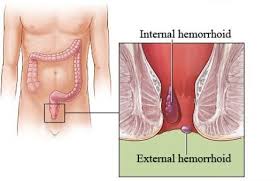The expansion considering the radicle rectal veins inside the anal region is well known as piles. Medically, piles are also often known as hemorrhoids. Arteries are generally pretty strong compared to veins. Veins are weak compared due to their thin walls and the moment there is before paying to much pressure on the veins, there is always pain or discomfort. There are actually three rectal veins: inferior middle and superior. Any obstructions or increase of pressure of these veins might lead to piles.
Looking for the position of the man or woman, there are two types of piles.
1) Internal piles (Internal Hemorrhoids).
2) External piles (External Hemorrhoids).
1) Internal piles (Internal Hemorrhoids):
They are actually seated in the anal canal and internal to the anal orifice. They are definitely covered by a mucous membrane and are purple or red in color. These internal piles are frequently painless.
2) External piles (External Hemorrhoids):
External piles are seen outside of the anal opening and are covered by skin. They are brown or black in color. This sort of external piles is generally very sore due to the many nerve endings in the surrounding area.
Sometimes external and internal piles happen in the same person concurrently.
Some reasons why some individuals get piles:
1) It's common in people who experience chronic constipation. Individuals that strain lots to experience a bowl movement, will usually are afflicted by internal or external piles, ultimately. Cure your irregular bowel movements and now you have a pretty good chance of avoiding piles.
2) Cancerous lesions inside the rectum can obstruct blood flow and result in piles.
3) Some women get piles during their pregnancy because of the compression of rectal veins through the uterus.
4) Piles are common in those who eat excess amounts of chicken, prawns, spicy foods, etc. Those that eat more vegetables and fibrous food rarely get piles.
5) It is a hereditary disease.
6) Piles only occur in animals that maintain an erect posture. This is a result of congestion of blood inside the rectal veins due to the results of gravity.
Symptoms and Signs of piles:
1) Many times you will find a discharge of puss with itching around the anal opening.
2) Pain - Pain is common if you receive external piles, which can worsen because you strain to defecate.
3) Bleeding - Blood will splash the bathroom bowl whenever you try to have a very bowel movement. The bleeding can be quite abundant now and then. Try not to be alarmed if the happens to you.
4) Protruding any muscles/skin - With external piles, the swelling might be felt close to the anal opening. In the case of internal piles, they may not be felt at the beginning. As soon as the disease worsens, the interior piles will exit during bowel movement and is going to go retreat back inside when you have finished. Like the condition worsens, the protruded internal piles won't retreat around the time off to the anus.
Some Complications of Piles:
1) Gangrene: Here the tissues in the piles and nearby skin die as a consequence of a shortage of your blood supply.
2) Fibrosis: Here the piles become fibrosis with hardening considering the anal orifice.
3) Infection: The infection can spread to the deep veins ending in septicemia.
4) Suppuration: In the event, the piles suppurate, it may produce an abscess having the discharge of puss.
5) Thrombosis: Here your blood stream stuck inside the piles will form clots and can obstruct the blood flow. For to learn more How to Get Rid of Hemorrhoids Fast at home.
Subscribe to:
Post Comments (Atom)
Effective Piles Relief - 5 Ways to Get Free of Developing hemorrhoids
The clinical name for piles is hemorrhoids. It becomes a number one goal to come with piles relief to produce a person facing this very pain...

-
Treating Rips Effectively Almost every gymnast at some point in his or her career will experience a trip. Very few are able to engage in g...
-
Hemorrhoid: Causes, Symptoms, and Treatments What is? Hemorrhoids are nodules or masses of tissue in the anus that contain dilated bloo...
-
With the recent debacle in Washington about health care and our current economic downturn, many people are either underinsured or uninsured....

No comments:
Post a Comment